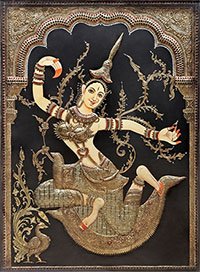Kanduyana, Kaṇḍūyana, Kamduyana: 15 definitions
Introduction:
Kanduyana means something in Hinduism, Sanskrit, Buddhism, Pali, Jainism, Prakrit. If you want to know the exact meaning, history, etymology or English translation of this term then check out the descriptions on this page. Add your comment or reference to a book if you want to contribute to this summary article.
In Hinduism
Kavya (poetry)
Source: Brill: Śaivism and the Tantric Traditions (kavya)Kaṇḍūyana (कण्डूयन) refers to “scratching”, according to Bāṇa’s Kādambarī (p. 226).—There is a mix of suspicion, fear and reverential awe underlying the image of the forbidding shrine tucked away in the wilds, with its Tāntrika priest who knows not how ‘appropriate’ worship should be conducted, and its blood-spattered, grisly interiors.The very opposite of this ambivalent attitude surfaces in Bāṇa’s unequivocally laudatory poem to Durgā, the Caṇḍīśataka—verse 8 of which is consciously alluded here in “she seemed to be scolding the wild buffalo who had offended by moving the trident-shaft by scratching (kaṇḍūyana) his shoulders [on it]”

Kavya (काव्य, kavya) refers to Sanskrit poetry, a popular ancient Indian tradition of literature. There have been many Sanskrit poets over the ages, hailing from ancient India and beyond. This topic includes mahakavya, or ‘epic poetry’ and natya, or ‘dramatic poetry’.
Sports, Arts and Entertainment (wordly enjoyments)
Source: archive.org: Syainika Sastra of Rudradeva with English Translation (art)Kaṇḍūyana (कण्डूयन) refers to the “preening” or “reforming” (of a hawk), according to the Śyainika-śāstra: a Sanskrit treatise dealing with the divisions and benefits of Hunting and Hawking, written by Rājā Rudradeva (or Candradeva) in possibly the 13th century.—Accordingly, [while discussing the training of hawks]: “[...] Whether it is ‘manned’ or not is to be known by its actions. When it stands on one leg with the eyes closed, when it preens or ‘reforms’ (kaṇḍūyana) its feathers, when it ‘mantles’ with its wings [cañcvā kaṇḍūyanaṃ caiva pakṣapālyorvidhūnanam], or looks with a gentle eye at its master, then it is known to be ‘manned’, otherwise not. When the hawk is seen to be manned it should be lured in a creance to a piece of meat from increasing distances. [...]”.

This section covers the skills and profiencies of the Kalas (“performing arts”) and Shastras (“sciences”) involving ancient Indian traditions of sports, games, arts, entertainment, love-making and other means of wordly enjoyments. Traditionally these topics were dealt with in Sanskrit treatises explaing the philosophy and the justification of enjoying the pleasures of the senses.
Languages of India and abroad
Pali-English dictionary
Source: BuddhaSasana: Concise Pali-English Dictionarykaṇḍūyana : (nt.) itching; scratching.
Source: Sutta: The Pali Text Society's Pali-English DictionaryKaṇḍūyana, (nt.) (See kaṇḍuvana) the itch J. V, 69. (Page 179)

Pali is the language of the Tipiṭaka, which is the sacred canon of Theravāda Buddhism and contains much of the Buddha’s speech. Closeley related to Sanskrit, both languages are used interchangeably between religions.
Sanskrit dictionary
Source: DDSA: The practical Sanskrit-English dictionaryKaṇḍūyana (कण्डूयन).—a. Scratching.
-nam Scratching, rubbing; कण्डूयनैर्दशनिवारणैश्च (kaṇḍūyanairdaśanivāraṇaiśca) R.2.5.
-nī A brush for rubbing.
-kaḥ A tickler; कर्णस्य कण्डूयनकेन वापि (karṇasya kaṇḍūyanakena vāpi) (tṛṇena kāryaṃ bhavatīśvarāṇām) Pañcatantra (Bombay) 1.71.
See also (synonyms): kaṇḍūyanaka.
Source: Cologne Digital Sanskrit Dictionaries: Shabda-Sagara Sanskrit-English DictionaryKaṇḍūyana (कण्डूयन).—n.
(-naṃ) 1. Itching. 2. Scratching; also kaṇḍūyā and kaṇḍū. E. As before, affixes yak and lyuṭ.
Source: Cologne Digital Sanskrit Dictionaries: Benfey Sanskrit-English DictionaryKaṇḍūyana (कण्डूयन).—i. e. kaṇdūya + ana, n. 1. Itching, [Bhāgavata-Purāṇa, (ed. Burnouf.)] 8, 7, 10. 2. Scratching, 3, 31, 26. 3. Stroking, [Vikramorvaśī, (ed. Bollensen.)] [distich] 151.
Source: Cologne Digital Sanskrit Dictionaries: Cappeller Sanskrit-English DictionaryKaṇḍūyana (कण्डूयन).—[neuter] scratching, itching.
Source: Cologne Digital Sanskrit Dictionaries: Monier-Williams Sanskrit-English Dictionary1) Kaṇḍūyana (कण्डूयन):—[from kaṇḍ] n. the act of scratching, scraping, rubbing
2) [v.s. ...] itching, the itch, [Kātyāyana-śrauta-sūtra; Suśruta; Raghuvaṃśa] etc.
Source: Cologne Digital Sanskrit Dictionaries: Yates Sanskrit-English DictionaryKaṇḍūyana (कण्डूयन):—(naṃ) 1. n. Idem.
Source: DDSA: Paia-sadda-mahannavo; a comprehensive Prakrit Hindi dictionary (S)Kaṇḍūyana (कण्डूयन) in the Sanskrit language is related to the Prakrit word: Kaṃḍuyaṇa.
[Sanskrit to German]
Sanskrit, also spelled संस्कृतम् (saṃskṛtam), is an ancient language of India commonly seen as the grandmother of the Indo-European language family (even English!). Closely allied with Prakrit and Pali, Sanskrit is more exhaustive in both grammar and terms and has the most extensive collection of literature in the world, greatly surpassing its sister-languages Greek and Latin.
Prakrit-English dictionary
Source: DDSA: Paia-sadda-mahannavo; a comprehensive Prakrit Hindi dictionaryKaṃḍuyaṇa (कंडुयण) in the Prakrit language is related to the Sanskrit word: Kaṇḍūyana.
Prakrit is an ancient language closely associated with both Pali and Sanskrit. Jain literature is often composed in this language or sub-dialects, such as the Agamas and their commentaries which are written in Ardhamagadhi and Maharashtri Prakrit. The earliest extant texts can be dated to as early as the 4th century BCE although core portions might be older.
Kannada-English dictionary
Source: Alar: Kannada-English corpusKaṃḍūyana (ಕಂಡೂಯನ):—[noun] = ಕಂಡೂತಿ [kamduti].
Kannada is a Dravidian language (as opposed to the Indo-European language family) mainly spoken in the southwestern region of India.
See also (Relevant definitions)
Starts with: Kanduyanaka.
Ends with: Kharakanduyana.
Full-text: Kanduyanaka, Kharakanduyana, Kanduyani, Kanduti, Kanduya, Cancu, Pakshapali, Pali.
Relevant text
Search found 1 books and stories containing Kanduyana, Kaṇḍūyana, Kamduyana, Kaṃḍuyaṇa, Kaṇḍuyaṇa, Kaṃḍūyaṇa, Kaṇḍūyaṇa, Kaṃḍūyana; (plurals include: Kanduyanas, Kaṇḍūyanas, Kamduyanas, Kaṃḍuyaṇas, Kaṇḍuyaṇas, Kaṃḍūyaṇas, Kaṇḍūyaṇas, Kaṃḍūyanas). You can also click to the full overview containing English textual excerpts. Below are direct links for the most relevant articles:
Dasarupaka (critical study) (by Anuru Ranjan Mishra)
Part 7 - Characters in the Mudritakumudacandra < [Chapter 10 - Prakaraṇa (critical study)]